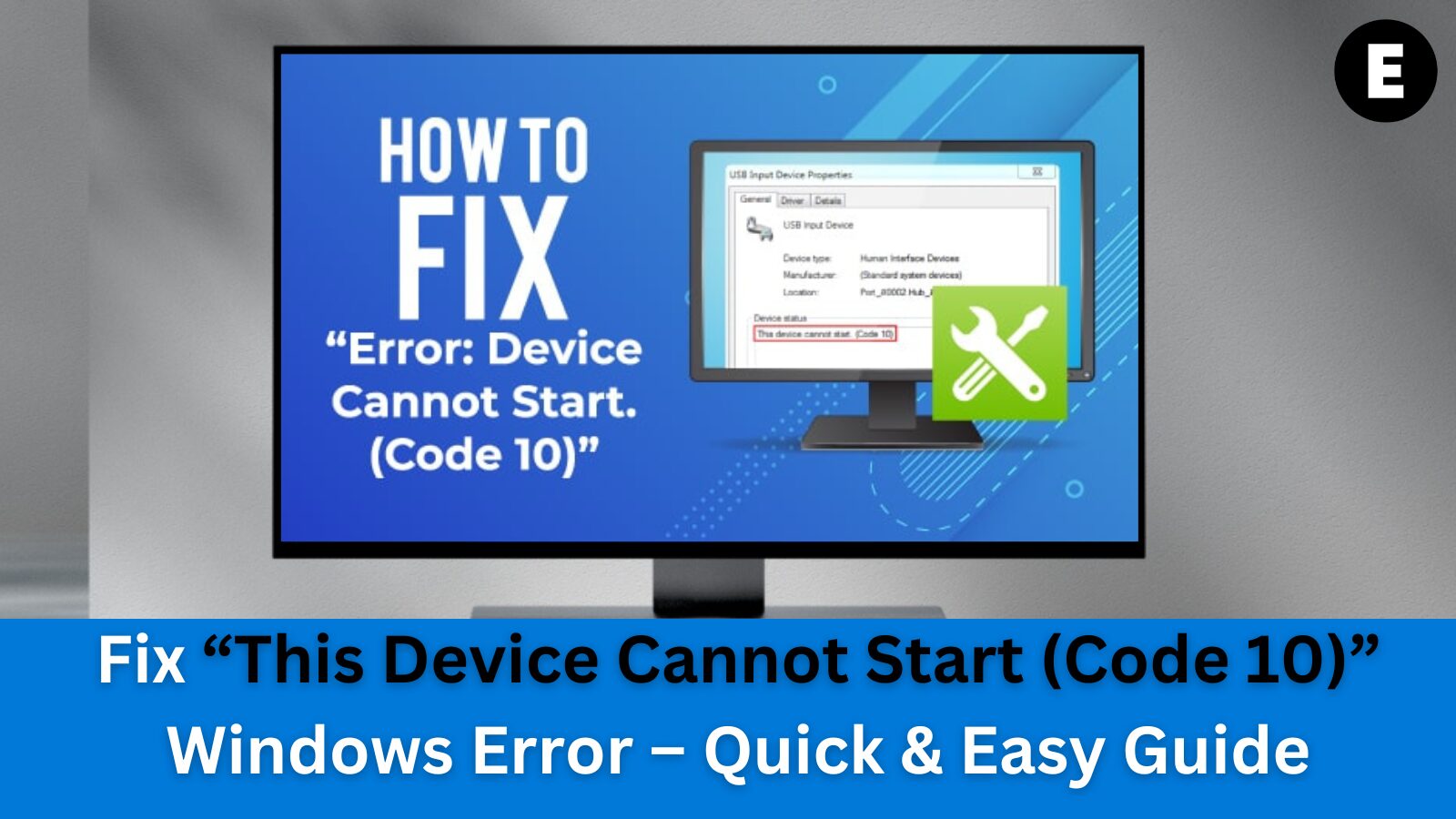Windows errors are frustrating, but the good news is—they’re usually easy to fix with the right steps. One common issue users face is the Windows error: “This device cannot start. (Code 10).” At first, this error might seem difficult to resolve, but with the right troubleshooting guide, it’s actually simple to fix.
This Code 10 error is linked to your Device Manager and can often seem technical or confusing. But don’t worry—we’ve created a step-by-step guide to help you fix the Code 10 error in Windows quickly and efficiently. Whether you’re a beginner or an advanced user, this guide will walk you through everything you need to know.
What Causes the Code 10 Error in Device Manager?
To ensure your computer runs smoothly, all installed hardware devices and drivers must work correctly. When something goes wrong—such as a corrupt driver, missing system files, or a temporary system glitch—you may encounter the dreaded “This device cannot start. (Code 10)” error in Device Manager.
What Does the Code 10 Error Message Look Like?
“This device cannot start. (Code 10)
{Operation Failed}
The requested operation was unsuccessful.”This specific Windows Device Manager error can be triggered by a variety of issues, including:
- Faulty or outdated drivers
- Missing or corrupted system files
- Incompatible hardware
- Temporary system conflicts
In simple terms, the Code 10 error indicates an unspecified driver or hardware issue that prevents your device from starting properly.
This error can occur on any modern version of Windows, including:
- Windows 11
- Windows 10
- Windows 8
- Windows 7
⚠️ Important: Code 10 errors shown in Device Manager are specific to device and driver-related issues. If you see a Code 10 error elsewhere on your system, it may point to a different problem and require other troubleshooting methods.
✅ Solved: This Device Cannot Start (Code 10) – Top 10 Fixes
Knowing how to fix driver-related errors is crucial, as these issues can lead to serious performance problems or even prevent your computer from functioning correctly. If you’re seeing the “This device cannot start (Code 10)” error, don’t worry—we’ve compiled the 10 best solutions to help you resolve driver issues, system conflicts, and more.
These solutions are optimized for Windows 10 and Windows 11, though some steps may differ slightly on older versions of Windows. If you ever need assistance, feel free to contact our support team—we’re here to help!
🔧 Method 1: Restart Your Computer
Sometimes, the simplest fix is the most effective. A system restart can clear out temporary glitches, flush memory, and refresh the Device Manager, resolving many common issues—including the Code 10 error.
How to Restart Your Computer on Windows 10/11:
- Click the Windows icon in the bottom-left corner of your screen to open the Start menu.
- Select the Power option.
- Click Restart.
Your system will now close all open applications and reboot from scratch.
👉 Once your computer has restarted, open Device Manager and check if the “This device cannot start (Code 10)” error still appears.
🔧 Method 2: Update the Problematic Device Driver
One of the most effective solutions to fix the “This device cannot start (Code 10)” error is to update your device drivers. Even if your drivers appear up to date, they may have become corrupted, incompatible, or outdated—all of which can trigger the Code 10 error.
Follow these steps to update the device driver that’s causing the issue:
🖱️ How to Update Device Drivers in Windows 10/11:
- Press Windows + X on your keyboard at the same time, then click on Device Manager from the menu.
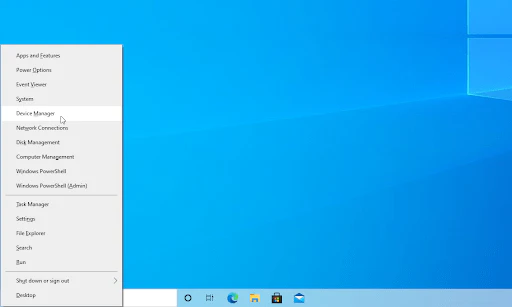
- In Device Manager, find the category of the problematic device and click the small arrow icon to expand it.
- Look for a device with a yellow exclamation mark—this indicates a problem.
- Right-click on the device and select Update Driver.
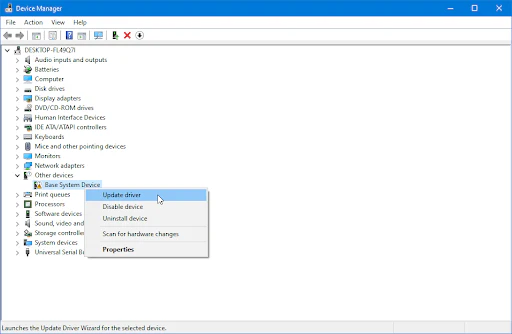
- Choose “Search automatically for updated driver software.” Windows will now look online for the latest version of the driver.
- 💡 Make sure your computer is connected to the internet during this process.
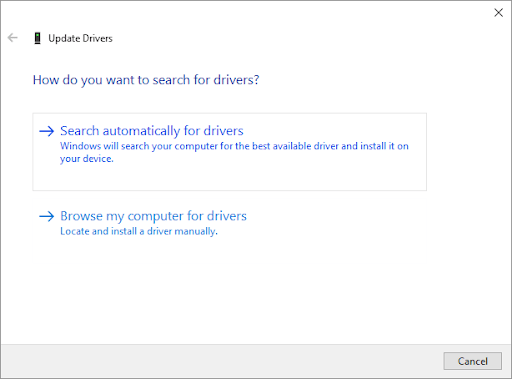
- If a newer driver is found, it will be downloaded and installed automatically.
- After the update is complete, restart your computer.
Once your system reboots, go back to Device Manager and verify if the Code 10 error has been resolved.
🔧 Method 3: Update Your Operating System
Sometimes, the “This device cannot start (Code 10)” error can be caused by underlying system issues that are resolved in the latest Windows updates. Keeping your operating system up to date ensures better compatibility with drivers and fixes for known bugs.
Here’s how to check for and install the latest Windows updates:
🪟 How to Update Windows 10/11:
- Click the Windows icon in the bottom-left corner of your screen to open the Start menu.
- Go to Settings (or press Windows + I to open it quickly).
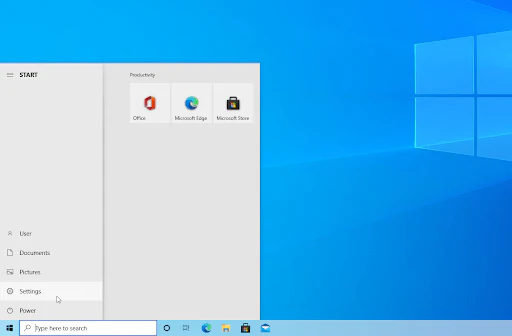
- Click on the Update & Security tile—this is where all Windows Update options are located.
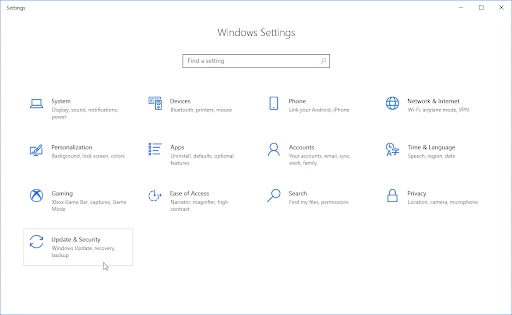
- Stay on the default Windows Update tab, then click Check for updates.
- 📝 If you see View all optional updates, click that to review and install additional updates, especially related to drivers.
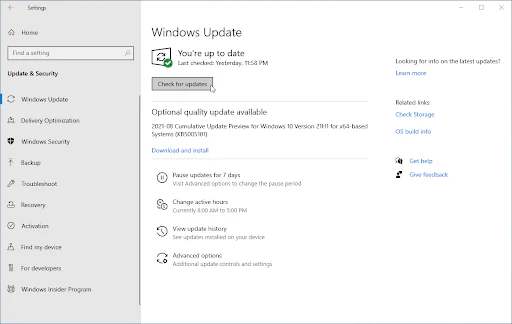
- If updates are available, click Install and allow Windows to download and apply updates automatically.
- After the updates are installed, restart your computer to apply changes.
Once your system is fully updated, open Device Manager again and check whether the Code 10 error has been resolved.
🔧 Method 4: Make a Registry Modification to Fix Code 10
The Windows Registry is a powerful tool that stores crucial system settings and configurations. It allows advanced users to tweak hidden system behaviors—and in this case, it can help resolve the “This device cannot start (Code 10)” error in Device Manager.
⚠️ Warning: Editing the Registry can be risky. A small mistake can lead to system instability. Always create a Registry backup before making any changes.
🧰 How to Modify the Windows Registry to Fix Code 10:
- Press Windows + R on your keyboard to open the Run dialog box.
- Type
regeditand hit Enter to open the Registry Editor.
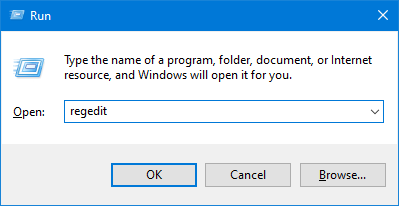
- Use the navigation pane or paste the following path into the Registry address bar:
HKEY_LOCAL_MACHINE\SYSTEM\CurrentControlSet\Control\Class
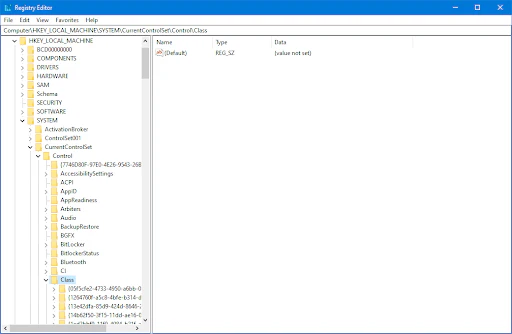
- You’ll now see a list of Class GUIDs (long alphanumeric strings in braces).
Locate the correct Class GUID for the device showing the Code 10 error. For example:{4D36E965-E325-11CE-BFC1-08002BE10318}(This one is commonly associated with network adapters.) - In the right-hand pane, look for the entries named UpperFilters and LowerFilters.
- Right-click each entry and select Delete.
- Confirm the deletion when prompted with a warning message: “Deleting certain registry values could cause system instability. Are you sure you want to permanently delete this value?”

- Once both entries are deleted, close the Registry Editor.
- Restart your computer to apply the changes.
After rebooting, check Device Manager to see if the Code 10 error has been resolved.
🔌 Method 5: Switch to a Powered USB Hub
Sometimes, the “This device cannot start. (Code 10)” error occurs because the connected USB device isn’t receiving enough power from your computer’s USB port. This is especially common with external hard drives, audio interfaces, and high-power peripherals.
⚡ Why Use a Powered USB Hub?
Standard USB ports (especially on older laptops or desktops) may not deliver sufficient voltage for certain devices. A powered USB hub, on the other hand, comes with its own power adapter, ensuring stable and consistent power supply to all connected devices.
💡 How to Fix Code 10 Using a Powered USB Hub:
- Unplug the problematic USB device from your PC.
- Connect a powered USB hub to your computer.
- Plug your USB device into the powered hub instead of directly into the PC.
- Wait for Windows to recognize the device and check if the Code 10 error disappears.
Powered USB hubs are affordable and widely available. You can purchase one from Amazon or other online retailers for as low as $19.99 (plus shipping).
✅ This simple hardware tweak can often resolve device initialization issues and restore full functionality.
🔧 Method 6: Roll Back the Driver
If you recently updated a driver and started experiencing the “This device cannot start (Code 10)” error, the issue may be due to an incompatible or faulty driver update. The Roll Back Driver option in Device Manager lets you revert to the previous version of the driver that worked correctly.
🔄 How to Roll Back a Driver in Windows 10/11:
- Press Windows + X and select Device Manager from the menu.
- Expand the category of the problematic device by clicking the small arrow icon next to it.
- Right-click on the device with the issue (look for a yellow exclamation mark) and choose Properties.
- In the new window, switch to the Driver tab.
- Click on Roll Back Driver (if the option is available).
- Follow the on-screen instructions, then restart your computer.
After rebooting, open Device Manager again to see if the Code 10 error is resolved.
🔧 Method 7: Uninstall and Reinstall the Driver
In some cases, a clean driver reinstall is the best solution—especially if the current driver files are corrupted, incomplete, or conflicting with your system. Reinstalling ensures that Windows loads a fresh, working copy of the driver.
🔁 Steps to Uninstall and Reinstall a Device Driver:
- Press Windows + X and click on Device Manager.
- Find the device with the error, expand its category by clicking the arrow, then right-click the device and choose Uninstall device.
- Confirm the uninstallation when prompted.
- After the driver is removed, click Action from the top menu and select Scan for hardware changes.
- Alternatively, click the scan icon on the toolbar.
- Windows will now automatically detect the device and reinstall the correct driver.
✅ Once reinstalled, check if the Code 10 error is still present. If not, it’s a good idea to create a system restore point—this way, you can easily return to this working configuration in the future.
🔧 Method 8: Use a System Restore Point
If the “This device cannot start. (Code 10)” error appeared recently, a previously created System Restore point may help you revert your system to a state before the issue began. This can automatically restore working drivers and remove any conflicting changes that triggered the error.
🕒 How to Perform a System Restore in Windows 10/11:
- Click the Search icon (🔍) on your taskbar or press Windows + S to open the search bar.
- Type System Restore and click on Recovery from the search results (under “Best Match”).
- In the Control Panel, select Open System Restore under the Advanced recovery tools section.
- Follow the on-screen instructions:
- Choose a recommended restore point or manually select one from the list.
- Review the programs and files that will be affected.
- Click Finish to begin the restore process and allow Windows to roll back to the selected system state.
Once the restoration is complete, reboot your computer and check the Device Manager to see if the Code 10 error is gone.
🛠️ Method 9: Replace the Faulty Hardware
In some cases, the Code 10 error is not caused by software but by damaged or defective hardware. If your device continues to malfunction despite trying all driver-related fixes, it may need to be repaired or replaced.
🧪 Steps to Confirm Hardware Failure:
- Disconnect the problematic device and test it on another computer.
- If the same Code 10 error appears, the issue likely lies with the hardware itself.
- Contact the manufacturer or retailer for a replacement or repair—especially if your device is still under warranty.
Investing in a working replacement may save you hours of troubleshooting and restore full functionality to your system.
🔁 Method 10: Refresh or Reinstall Windows
If you’ve tried everything and the Code 10 error still persists, a system reset or clean Windows installation may be the only solution. This process gives your computer a fresh start, eliminating any corrupted system files or deep-rooted software issues.
🧹 How to Refresh or Reinstall Windows:
- Open Settings (press Windows + I) and go to Update & Security > Recovery.
- Under Reset this PC, click Get started.
- Choose one of the following options:
- Keep my files – reinstalls Windows without deleting your personal data.
- Remove everything – performs a clean reinstall (best for serious issues).
- Follow the prompts to complete the reset or reinstall.
⚠️ Note: You may need to reinstall applications and reconfigure system settings afterward.
After reinstallation, install the latest drivers and check if the Code 10 error is resolved in Device Manager.
One more thing
If you’re in search of a software company that embodies integrity and upholds honest business practices, your quest ends here at Ecomkeys.com. As a Microsoft Certified Partner, we prioritize the trust and satisfaction of our customers. Our commitment to delivering reliable software products is unwavering, and our dedication to your experience extends far beyond the point of sale. At Ecomkeys.com, we provide a comprehensive 360-degree support system that accompanies you throughout your software journey. Your trust is our foundation, and we’re here to ensure that every interaction with us is a positive and trustworthy one.

